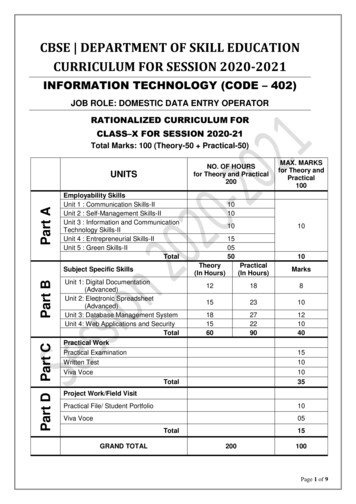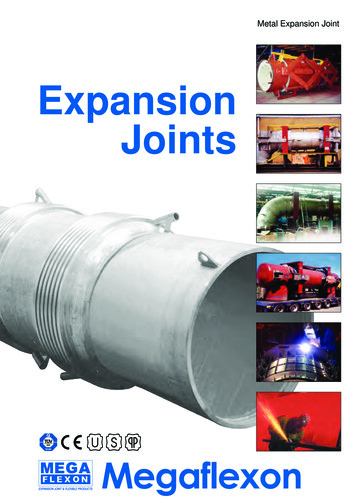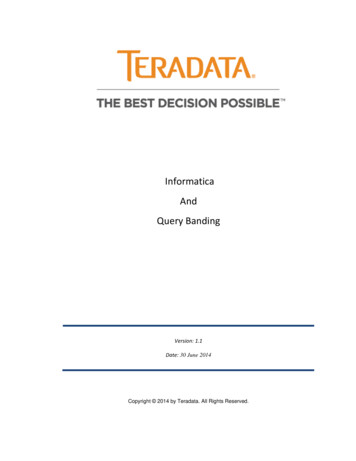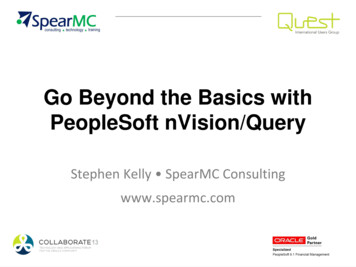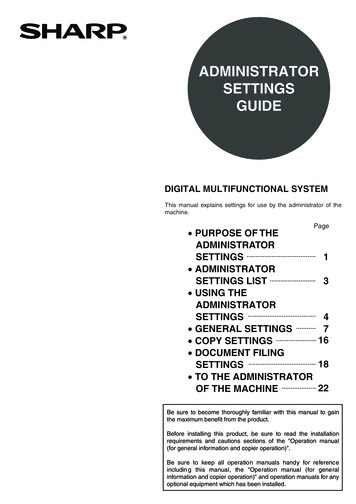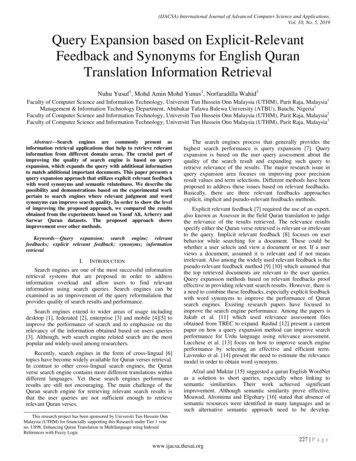
Transcription
(IJACSA) International Journal of Advanced Computer Science and Applications,Vol. 10, No. 5, 2019Query Expansion based on Explicit-RelevantFeedback and Synonyms for English QuranTranslation Information RetrievalNuhu Yusuf1, Mohd Amin Mohd Yunus2, Norfaradilla Wahid3Faculty of Computer Science and Information Technology, Universiti Tun Hussein Onn Malaysia (UTHM), Parit Raja, Malaysia1Management & Information Technology Department, Abubakar Tafawa Balewa University (ATBU), Bauchi, Nigeria1Faculty of Computer Science and Information Technology, Universiti Tun Hussein Onn Malaysia (UTHM), Parit Raja, Malaysia2Faculty of Computer Science and Information Technology, Universiti Tun Hussein Onn Malaysia (UTHM), Parit Raja, Malaysia3Abstract—Search engines are commonly present asinformation retrieval applications that help to retrieve relevantinformation from different domain areas. The crucial part ofimproving the quality of search engine is based on queryexpansion, which expands the query with additional informationto match additional important documents. This paper presents aquery expansion approach that utilizes explicit relevant feedbackwith word synonyms and semantic relatedness. We describe thepossibility and demonstrations based on the experimental workpertain to search engines where relevant judgment and wordsynonyms can improve search quality. In order to show the levelof improving the proposed approach, we compared the resultsobtained from the experiments based on Yusuf Ali, Arberry andSarwar Quran datasets. The proposed approach showsimprovement over other methods.Keywords—Query expansion; search engine; relevantfeedbacks; explicit relevant feedback; synonyms; informationretrievalI.INTRODUCTIONSearch engines are one of the most successful informationretrieval systems that are proposed in order to addressinformation overload and allow users to find relevantinformation using search queries. Search engines can beexamined as an improvement of the query reformulation thatprovides quality of search results and performance.Search engines extend to wider areas of usage includingdesktop [1], federated [2], enterprise [3] and mobile [4][5] toimprove the performance of search and to emphasize on therelevancy of the information obtained based on users queries[3]. Although, web search engine related search are the mostpopular and widely-used among researchers.Recently, search engines in the form of cross-lingual [6]topics have become widely available for Quran verses retrieval.In contrast to other cross-lingual search engines, the Quranverse search engine contains more different translations withindifferent languages. Yet these search engines performanceresults are still not encouraging. The main challenge of theQuran search engine for retrieving relevant search results isthat the user queries are not sufficient enough to retrieverelevant Quran verses.The search engines process that generally provides thehighest search performance is query expansion [7]. Queryexpansion is based on the user query assessment about thequality of the search result and expanding such query toretrieve relevance of the results. The major research issue inquery expansion area focuses on improving poor precisionresult values and term selections. Different methods have beenproposed to address these issues based on relevant feedbacks.Basically, there are three relevant feedbacks approachesexplicit, implicit and pseudo-relevant feedbacks methods.Explicit relevant feedback [7] required the use of an expert,also known as Assessor in the field Quran translation to judgethe relevance of the results retrieved. The relevance resultsspecify either the Quran verse retrieved is relevant or irrelevantto the query. Implicit relevant feedback [8] focuses on userbehavior while searching for a document. These could bewhether a user selects and view a document or not. If a userviews a document, assumed it is relevant and if not meansirrelevant. Also among the widely used relevant feedback is thepseudo-relevant feedback method [9] [10] which assumed thatthe top retrieved documents are relevant to the user queries.Query expansion methods based on relevant feedbacks proofeffective in providing relevant search results. However, there isa need to combine these feedbacks, especially explicit feedbackwith word synonyms to improve the performance of Quransearch engines. Existing research papers have focused toimprove the search engine performance. Among the papers isJakub et al. [11] which used relevance assessment filesobtained from TREC to expand. Rashid [12] present a currentpaper on how a query expansion method can improve searchperformance for Urdu language using relevance assessment.Lucchese et al. [13] focus on how to improve search engineperformance by selecting an effective and efficient term.Lavrenko et al. [14] present the need to estimate the relevancemodel in order to obtain word synonyms.Afzal and Muktar [15] suggested a quran English WordNetas a solution to short queries, especially when linking tosemantic similarities. Their work achieved significantimprovement. Although semantic similarity prove effective,Moawad, Alromima and Elgohary [16] stated that absence ofsemantic resources were identified in many languages and assuch alternative semantic approach need to be develop.This research project has been sponsored by Universiti Tun Hussein OnnMalaysia (UTHM) for financially supporting this Research under Tier 1 voteno. U898, Enhancing Quran Translation in Multilanguage using IndexedReferences with Fuzzy Logic227 P a g ewww.ijacsa.thesai.org
(IJACSA) International Journal of Advanced Computer Science and Applications,Vol. 10, No. 5, 2019Bentrcia, Zidat and Marir [17] examine the possibility of usingsemantic relatedness instead of only semantic similarities. Thispaper used only semantic relatedness to obtain relationshipbetween two concepts using “AND” conjunctive. However,Lashkari, Bagheri and Ghorbani [18] identified based on theliteratures that depending only on semantic resource wouldn’timprove better search performance. Integrations of othermethods with semantic was suggested to yield better results.This paper utilizes explicit-relevant feedback with combinedWordNet and semantic relatedness to expand the query.The remainder of this paper is organized as follows:Section 2 will provide a review of related work on queryexpansion methods based on relevant feedback and how thesemethods improve search performance; Section 3 describes theproposed approach using explicit relevant feedback andsynonyms; Section 4 present the experiments conducted, andfinally, Section 5 present the conclusion and future work.II. RELATED WORKA. Query Expansion MethodsMany query expansion techniques are now available fortesting the performance of search engines. According to Azad& Deepak [7], query expansion techniques can be categorizedinto fourteen (14) techniques. These techniques can be in eitherglobal or local analysis query expansion. However, in practice,only a few successfully improve search engine results. Themost commons ones found effective are WordNet, thesaurus,explicit feedback, implicit feedback, pseudo-relevancefeedback and Wikipedia. Each of the techniques can be appliedto different scenario depending on the performance of thesearch engine you want to improve. Explicit, implicit andpseudo-relevance feedbacks are important in improving theperformance of search results using relevance feedbacks fromusers. Others also play major roles in various searchimprovements.B. Query Expansion Methods based on Relevance FeedbacksMany query expansion techniques have been used over theyears. The explicit feedback technique has shown effective inretrieving the quality results from the search engine. In explicitfeedback, a query will be sent to the search engine. The expertwill be asked to judge the relevance of the results obtainedfrom that query. Also, an expert must have prior knowledge ofthe domain are considered. The results that expert judged mostrelevant will be given to a system to compute the performancesearch engine. Liu et al [19] proposed a method that combinesboth explicit and implicit feedbacks into consideration. Theyemphasize addressing the challenges that may come from thetop-N recommendation. Jiang, He and Allan [20] suggested theuse of multiple explicit feedbacks for improving the relevantjudgment in subsequent information retrieval evaluations. Theyused both the implicit feedback during user sessions andexplicit feedback using at least four criteria. Their evaluationsshowed that explicit feedback has a relationship with the userexperience. Mach et al. [21] evaluate whether including expertjudgment can yield positive results in climate changeassessment. They invited experts from different domains fortheir inputs on the issues. Their result shows that using expertjudgment can transparently and consistently improve thequality of the needed results. Lester et al. [22] developed aframework incorporating expert judgment to minimizesinconsistency in the provided results. Their concern is toevaluate analogue structure-activity relationships (SAS).However, the bias in expert judgment [23] may reduce thequality of the results. This is because of the inappropriate useof experts from other domains. Wilson [24] presented the useof multiple experts in the evaluation in order to bias. The studyconsidered from within and outside the organization. Theresults indicate multiple experts can have more relationshipthan within. According to Hasanain [25] present how thesystem can use automatic ranking without consideringrelevance expert judgment. But, Alvarado-Valencia [26] arguethat including expert judgment can ensure system credibility.Verma et al. [27] use various relevant judgment collected fromdesktop and mobile experts. The result indicates desktop canmany nonrelevant documents in addition to few relevanceones.Implicit feedback technique that deduces what the users’intent to do based on their observed behaviours. Understandinguser behaviour can significantly improve the performance ofsearch engine [28]. The implicit feedback is a good techniquefor measuring similarities [8] of many documents based onuser search behaviour. The search behavior may be from onlinepurchase history [29][30][31], browsing history [29][32],search patterns [31][33][34], or even mouse movements[35][34]. All these prove effective in infer intention for aparticular search engine. For instance, Kawasaki and Hasuike[29] show browsing history can be utilized to provide arecommendation to users in electronic commerce sites. Ghosh,Rath and Shah [33] present how the complexity of the websearch engine can be improved using users search behaviourlogs. Xie et al., [34] stated that search behaviour pattern canreveal users intention within the search environment. Thesesearch behaviour pattern can see mostly in terms of click timeor query reformulations. Kwok [35] also found that mouseclick can easily predict the intention of users in searchingneeded information. Recently, Zhang et al., [36] investigatedhow implicit feedback collected user search behaviour canimprove the quality of search results. They manipulated therelevant documents obtained from the top rank documents list.However, their investigation does not consider the semanticrelationship between various search behaviours which canprovide effective search quality.Pseudo-Relevance Feedback, which others refer to as blindrelevance feedback, is another query expansion technique thatcan improve search performance. Pseudo-relevance feedbackcan address mismatch vocabulary challenges [10]. It canimprove search results without users’ involvement.Montazeralghaem, Zamani and Shakery [37] reveal thatPseudo-relevance feedback that utilizes a number of top-rankdocuments will improve search effectiveness. Albishre et al.,[9] proposed a pseudo-relevance feedback model to addressmicroblog documents mismatching issues. They consideredhow a query can be modified in order to improve users’performance. Furthermore, Na and Kim [38] suggest that theperformance of pseudo-relevance feedback model can only bereasonably achieved when the document length have beennormalized. They expanded the query by adding a few228 P a g ewww.ijacsa.thesai.org
(IJACSA) International Journal of Advanced Computer Science and Applications,Vol. 10, No. 5, 2019additional terms to increase the size of the query. That meansthe size of the query should be neither not too short nor toohigh. Expanding query with multiple terms [39] can improvethe performance of search engines than using single or fewterms. They proposed a technique that can combine multipleterms using fuzzy logic. Also, Bayesian [40] with manyretrieval models can effectively improve search performance.They considered using models that can allow users to searchfor information using a query and optimize the results.Furthermore, Singh and Sharan [41] proposed a model thatconsidered multiple selection terms in order to obtain relevantdocuments. Their model utilizes explicit-relevance feedback inretrieving a number of relevant documents.III. PROPOSED APPROACHSimilar to other query expansion, our proposed methodutilizes three traditional ranking algorithms. However, aftercomputing search performance, the algorithm that providesbetter results was used to expand our query. In this case, ourproposed query expansion method utilizes the BM25algorithm. Furthermore, we improve the search results ofBM25 with synonyms and we called the new algorithm QEES.Firstly, based on the idea of vector space model, the cosinesimilarity between term X and Y was computed using theequation (1).()(1) The synonyms of QEES can be computed using equation(2):(2)Whererepresent the modified query based on thesimilarities of words in WordNet and the original query. Therepresents a number of times the word in and have seentogether and ,represent the number of times that seeneach of the word and . We assume that and representour original query and the WordNet respectively. We also* and* ,assume that and * representwhere both *various words.Furthermore, we compute the BM25 ranking withsynonyms for an expanded query on a document usingequation (3) below:(Where))((()() )(3)can also be calculated in equation (4):(4)D represents a document in a corpus and therepresentthe expanded query. The total number of the document isrepresented as N while the number of documents containingthe appended word synonyms. Moreover, the appended wordsynonyms term frequency in document D is represented as(). The length of document D in words and the averagelength in the text collection are denoted as D and avgdlrespectively. The free parameters for search optimization arerepresented by and .IV. EXPERIMENTSA. Datasets and QueriesWe conduct our experiment on Yusuf Ali, Sarwar andArberry English version datasets. These three datasets arecollected from Tanzil [42]. Yusuf Ali is an English Qurantranslation dataset by Islamic scholar Abdullahi Yusuf Ali. Thescholar was born in India and wrote many Islamic booksduring his lifetime. This dataset gains acceptance by manyEnglish speaking countries. The second dataset is Arberrywhich is also another English version of Quran translationdataset by Arthur John Arberry. Arthur John Arberry is a nonMuslim scholar but helps to translate the Quran into English.Finally, the Sarwar is third Quran translated dataset used byShaykh Muhammad Sarwar. He is an Islamic scholar fromPakistan who publishes some Islamic books including theQuran English translation.It is not necessarily that every quran translation dataset beaccepted to other sects. Therefore, as a source of our dataset,we select these datasets because Tanzil [42] is free from anysect or country bias.Each dataset is given as a single document and contained6236 verses represented by lines. Therefore, we transformedeach verse into a single document which we got 6236documents are available in each of the datasets. We saved eachdocument with its chapter and verse for easy representation.For instance, 003045 represent chapter 003 verse 045. Thismean, the first 3 figures represent the chapter while the last 3represent the verse.We believed the search results can only be obtained if thedocument contains a query keyword. Moreover, we understandthat not every query provide better search results based on thestudies conducted by Yusuf et al [43]. Therefore, we adopted36 queries used in Ahmad et al [44] which combine differenttypes of queries. Furthermore, our proposed approach used anEnglish WordNet provided by Princeton University [45].Version 2.1 of the WordNet has been used to target synonymswords.B. Evaluation MetricsMost of the research papers used precision, recall and meanaverage precision [1][2] to evaluate quran informationretrieval. However, the proposed QEES used Averageprecision, average recall, mean reciprocal rank and meanaverage precision metrics for evaluation.The position at which each ranked document provides therelevant document will determine average precision as inequation (5): ( )(5)Average recall utilizes the position at which each rankeddocument provides the retrieved document as computed inequation (6): ( )(6)229 P a g ewww.ijacsa.thesai.org
(IJACSA) International Journal of Advanced Computer Science and Applications,Vol. 10, No. 5, 2019Equation (7) presents a mean average precision which usesrankings from different users’ queries and then averages themto obtain average precision. ( )(7)The mean reciprocal rank computes the reciprocal rankaverage above queries sets and computed in equation (8): (8)C. BenchmarkWe utilize the explicit-relevant feedback provided byQuran translation experts in Ahmed et al [44]. This documentserves as a benchmark for our proposed method. As we obtainthe results from the search engine algorithm, they would becompared with the benchmark to separate relevant documentsretrieved from the irrelevant ones. Both relevant and irrelevantretrieve will be used to compute search performance.D. ComparisonsIn this experiment, the proposed QEES method will becompared against different traditional ranking algorithms.Specifically, we will compare our proposed method againstoriginal BM25, TF-IDF and Lucene algorithms.E. PerformanceIn this experiment, the proposed QEES method will becompared against different traditional ranking algorithms.Specifically, we will compare our proposed method againstoriginal BM25, TF-IDF and Lucene algorithms.Table III tabulates the average precision and recallsobtained from the three datasets based on the 36 queries used.From the results, we can notice that our proposed QEESperform best on Yusuf Ali dataset.In terms of the results obtained, Fig. 1 and 2 represent meanaverage precision (MAP) and mean reciprocal rank (MRR) theresults obtained with Yusuf Ali, Sarwar and Arberry datasets.Fig. 1 shows the MAP in Yusuf Ali dataset by making useof BM25, tf-idf, Lucene and proposed QEES. The proposedQEES perform better in retrieving relevance results. It achieves17.75% improvements as compared to BM25 with 16.23%, tfidf with 11.19% and Lucene with 5.39%.Fig. 2 shows the MRR in Yusuf Ali dataset achieved withBM25, tf-idf, Lucene and expanded synonyms. The order ofthe probability of documents is important, as it is the basis forranking first correct answers in ranked documents. As therelevant documents are retrieved, only the rank of the relevantdocuments is considered, other relevant answers are allignored. When comparing the results, the search engine has10.58% performances when applying proposed QEES which isless than the TFIDF with 11.01%.In summary, the proposed QEES using Yusuf Ali datasetproves effective on the MAP. The performance of varioussearch engine methods proved that relevant results can beobtained for a particular search query.For Arberry dataset, the results obtained in Fig. 1 havesome similarities with the Sarwar datasets on the MAP.However, the BM25 and the proposed QEES slightly havelittle differences. The proposed QEES is inferior in retrievingrelevant results. It improves search performance by achieving9.28% as compared to the Lucene method with 16.43% andBM25 with 10.07%.Fig. 2 also shows the MRR on Arberry dataset where10.04% has been achieved on BM25 as compared to theproposed QEES with 7.53% results.The Sarwar dataset results in Fig. 1 show the searchperformance on four search methods. Although a proposedQEES is significant on MAP as compared to BM25 traditionalmethod, the MRR result with BM25 is higher than theproposed QEES. Such results can be applied to practicalsituations. Moreover, Fig. 2 shows the BM25 method has9.47% results as compared to TFIDF with 6.39%, Lucene with7.95% and proposed QEES with 9.07%.Interestingly, as shown in Tables I and II, the resultsobtained in Yusuf Ali dataset using BM25 and proposed QEESperform significantly on the MAP. Arberry and Sarwar datasetsperform better on Lucene using MAP. In terms of MRR, YusufAli performs best with TFIDF. Sarwar and Arberry performbest on BM25 and Lucene respectively on MRR.2018161412Yusuf Ali10Sarwar8Arberry6420BM25TFIDFLuceneProposed QEESFig. 1. MAP Search Performance Results on the Three Datasets.230 P a g ewww.ijacsa.thesai.org
(IJACSA) International Journal of Advanced Computer Science and Applications,Vol. 10, No. 5, 20191412108Yusuf AliSarwar6Arberry420BM25TFIDFLuceneProposed QEESFig. 2. MRR Search Performance Results on the Three Datasets.TABLE I.DatasetsMAP SEARCH PERFORMANCE RESULTS ON THE THREE posed Method17.75BM2513.25TFIDF7.72Lucene10.76Proposed Method16.36BM2510.07TFIDF6.14Lucene16.43Proposed QEES9.28Yusuf AliSarwarArberryTABLE II.DatasetsMRR SEARCH PERFORMANCE RESULTS ON THE THREE osed Method10.58BM259.47TFIDF6.39Lucene7.95Proposed Method9.07BM2510.04TFIDF7.16Lucene12.37Proposed QEES7.53Yusuf AliSarwarArberry231 P a g ewww.ijacsa.thesai.org
(IJACSA) International Journal of Advanced Computer Science and Applications,Vol. 10, No. 5, 2019TABLE III.AVERAGE PRECISION AND RECALL SEARCH PERFORMANCE RESULTS ON THE THREE DATASETSYusuf AliSarwarArberryQueriesAverage RecallAverage PrecisionAverage RecallAverage PrecisionAverage RecallAverage 232 P a g ewww.ijacsa.thesai.org
(IJACSA) International Journal of Advanced Computer Science and Applications,Vol. 10, No. 5, 2019V. CONCLUSION AND FUTURE WORKThe performance of any search engine is a crucial part ofthe success of any search engine across various domains.Therefore, in this paper, we have presented a query expansionmethod that utilizes explicit relevant feedback and wordsynonyms for improving the performance of Quran web searchengine. The improvement can be seen in terms of meansaverage precision and mean reciprocal rank performance,average precision and recall.The proposed QEES new approach to query expansion hasmany benefits; especially it can be used across different searchengine algorithms to rank documents according to relevance.The proposed QEES achieved as per as 1.19723151 on theMAP which is a significant improvement when compared toother methods. Furthermore, the proposed approach can beable to retrieve reciprocal ranks of results for a given query.For future work, our research experiments have shown howa word that is exactly or nearly the same use to improve searchresults. We observed that relevant documents have useddifferent terms. In contrast, the search engine must have adistributed representation of term with semantics metadata sothat meaning of a word can be better processed using machinelearning algorithms such as neural network and therefore abeneficial to improve the performance of query expansion forbetter results.ACKNOWLEDGMENTThe authors would like to thank the Center for GraduateStudies Universiti Tun Hussein Onn Malaysia (UTHM), theFaculty of Computer Science & Information TechnologyUTHM and indeed the faculty of Management Science,Abubakar Tafawa Balewa University (ATBU) Bauchi for theirsupport during this research paper.[1][2][3][4][5][6][7][8][9]REFERENCESM. S. Raje, “Analysis of Desktop Search and Ranking of Their ResultsBased on Semantics from User Feedback,” 2016 12th Int. Conf. SignalImage Technol. Internet-Based Syst., pp. 241–245, 2016.M. Dragoni, A. Rexha, H. Ziak, and R. Kern, “A semantic federatedsearch engine for domain-specific document retrieval,” Proc. ACMSymp. Appl. Comput., vol. Part F1280, pp. 303–308, 2017.U. Kruschwitz and C. Hull, “Searching the Enterprise,” Found. Trends Inf. Retr., vol. 11, no. 1, pp. 1–142, 2017.C. Luo, Y. Liu, T. Sakai, F. Zhang, M. Zhang, and S. Ma, “EvaluatingMobile Search with Height-Biased Gain,” Proc. 40th Int. ACM SIGIRConf. Res. Dev. Inf. Retr. - SIGIR ’17, pp. 435–444, 2017.J. Mao, Y. Liu, N. Kando, Z. He, and M. Zhang, “A Two-Stage Modelfor User ’ s Examination Behavior in Mobile Search,” Assoc. Comput.Mach., pp. 273–276, 2018.G. Chandra and S. K. Dwivedi, “Query expansion based on termselection for Hindi - English cross lingual IR,” J. King Saud Univ. Comput. Inf. Sci., 2017.H. K. Azad and A. Deepak, Query Expansion Techniques for InformationRetrieval: a Survey. 2017.M. Liu, W. Pan, M. Liu, Y. Chen, X. Peng, and Z. Ming, “Mixedsimilarity learning for recommendation with implicit feedback,”Knowledge-Based Syst., vol. 119, pp. 178–185, 2017.K. Albishre, Y. Li, and Y. Xu, “Effective pseudo-relevance for Microblogretrieval,” Proc. Australas. Comput. Sci. Week Multiconference - ACSW’17, pp. 1–6, 2017.[10] R. Cummins, “Improved Query-Topic Models Using Pseudo-RelevantPólya Document Models,” Proc. ACM SIGIR Int. Conf. Theory Inf. Retr.- ICTIR ’17, pp. 101–108, 2017.[11] Jakub Dutkiewicz and C. Jędrzejek, “Calculating Optimal Queries fromthe Query Relevance File,” in Proceedings of the 11th InternationalConference MISSI, 2018, pp. 249–259.[12] I. Rasheed and H. Banka, “Query Expansion in Information Retrieval forUrdu Language,” 2018 Fourth Int. Conf. Inf. Retr. Knowl. Manag., pp. 1–6, 2018.[13] C. Lucchese, F. M. Nardini, and R. Trani, “Efficient and Effective QueryExpansion for Web Search,” pp. 1551–1554, 2018.[14] V. Lavrenko and W. B. Croft, “Relevance based language models,” Proc.24th Annu. Int. ACM SIGIR Conf. Res. Dev. Inf. Retr. - SIGIR ’01, pp.120–127, 2001.[15] H. Afzal and T. Mukhtar, “Semantically Enhanced Concept Search of theHoly Quran: Qur’anic English WordNet,” Arab. J. Sci. Eng., 2019.[16] I. Moawad, W. Alromima, and R. Elgohary, “Bi-Gram TermCollocations-based Query Expansion Approach for Improving ArabicInformation Retrieval,” Arab. J. Sci. Eng., vol. 43, no. 12, pp. 7705–7718,2018.[17] R. Bentrcia, S. Zidat, and F. Marir, “Extracting Semantic Relations fromthe holy Quran Based on Arabic Conjunctive Patterns,” Comput. Intell.,vol. 30, pp. 382–390, 2016.[18] F. Lashkari, E. Bagheri, and A. A. Ghorbani, “Neural embedding-basedindices for semantic search,” Inf. Process. Manag., vol. 56, no. 3, pp.733–755, 2019.[19] N. N. Liu, E. W. Xiang, and M. Zhao, “Unifying Explicit and ImplicitFeedback for Collaborative Filtering,” in IEEE 2nd InternationalConference on Big Data Analysis, 2017, pp. 1445–1448.[20] J. Jiang, D. He, and J. Allan, “Comparing In Situ and MultidimensionalRelevance Judgments,” Proc. 40th Int. ACM SIGIR Conf. Res. Dev. Inf.Retr. - SIGIR ’17, pp. 405–414, 2017.[21] K. J. Mach, M. D. Mastrandrea, P. T. Freeman, and C. B. Field,“Unleashing expert judgment in assessment,” Glob. Environ. Chang., vol.44, pp. 1–14, 2017.[22] C. Lester, A. Reis, M. Laufersweiler, S. Wu, and K. Blackburn,“Structure activity relationship (SAR) toxicological assessments: The roleof expert judgment,” Regul. Toxicol. Pharmacol., vol. 92, no. January,pp. 390–406, 2018.[23] J. R. Axt, H. Nguyen, and B. A. Nosek, “The Judgment Bias Task: Areliable flexible method for assessing individual differences in socialjudgment biases.,” J. Exp. Soc. Psychol., no. February, pp. 1–19, 2018.[24] K. J. Wilson, “An investigation of dependence in expert judgementstudies with multiple experts,” Int. J. Forecast., vol. 33, no. 1, pp. 325–336, 2017.[25] M. Hasanain, “Automatic Ranking of Information Retrieval Systems,” inThe 11th ACM International Conference on Web Search and DataMining, 2018.[26] J. Alvarado-Valencia, L. H. Barrero, D. Önkal, and J. T. Dennerlein,“Expertise, credibility of system forecasts and integration methods injudgmental demand forecasting,” Int. J. Forecast., vol. 33, no. 1, pp. 298–313, 2017.[27] N. Craswell, “Study of Relevance and Effort across Devices,” inProceedings of the 2018 Conference on Human InformationInteraction&Retrieval, 2018, pp. 309–312.[28] A. H. Awadallah, “LearnIR : WSDM 2018 Workshop on Learning fromUser Interactions,” in Proceedings of the Eleventh ACM InternationalConfe
also known as Assessor in the field Quran translation to judge the relevance of the results retrieved. The relevance results specify either the Quran verse retrieved is relevant or irrelevant to the query. Implicit relevant feedback [8] focuses on user behavior while searching for a document. These could be

